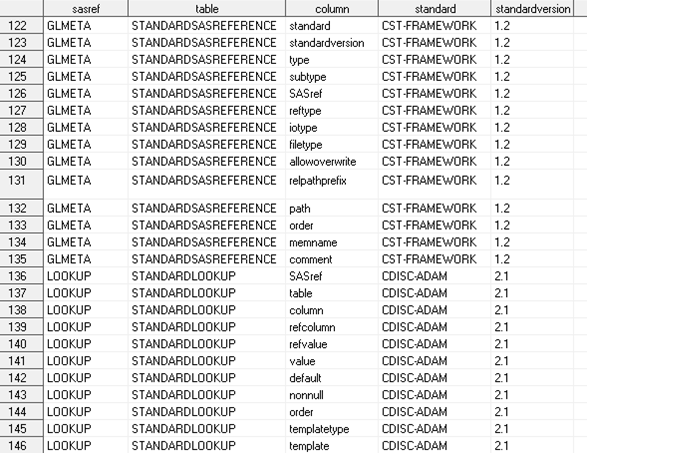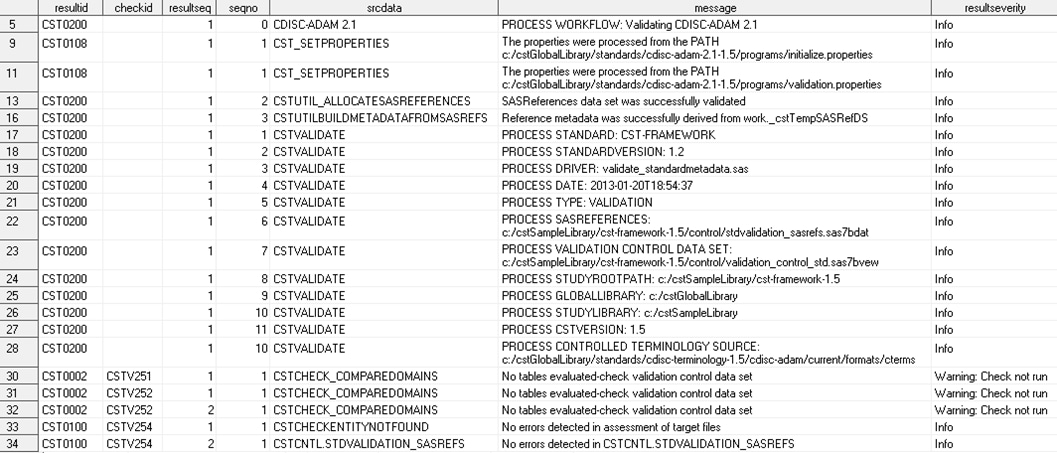Sample Driver Modules
Overview
The SAS Clinical Standards
Toolkit internal validation addresses two primary use cases:
Internal Validation Driver Modules That Are Provided by SAS
A summary of the driver
modules that support internal validation, including these two specific
use cases, is here:
-
validation_control files used: validation_control_glmeta view, validation_control_stdiqoq view, checktype in (‘GLMETA’ ‘STDIQOQ’)Purpose: First, runs checks only on CST-FRAMEWORK global standards library metadata (n=64 checks). Then, runs checks on one or more standards as specified in the driver. Thirty checks are run for each selected standard. These are the checks that support installation qualification and operational qualification for the SAS Clinical Standards Toolkit 1.5.
The validate_data driver
is similar in functionality to other standard-specific drivers (such
as the CDISC-SDTM validate_data driver). It runs against a validation_control
data set with no subsetting by standard or by check. For the simpler
workflow, see the validate_data driver module in the online API documentation.
A complete discussion
of the use of the validate_iqoq driver module is provided in SAS
Clinical Data Standards Toolkit: Installation Qualification,
which is available at: http://support.sas.com/documentation/onlinedoc/clinical/index.html.
Internal Validation Driver Module Workflow: validate_standard
This driver module performs
all standard-specific validation checks. This excludes checks that
target the
global standards library directory/metadata folder
files. Essentially, this is any check defined in validation_master,
where checktype NE ‘GLMETA’.
Here is the validate_standard
driver workflow:
-
*************************************************************************; * User defines standard(s) of interest in the following data step *; *************************************************************************; data work._cstStandardsforIV; set work._cstAllStandards (where=( (upcase(standard) = 'CDISC-ADAM' and standardversion='2.1') or (upcase(standard) = 'CDISC-CRTDDS' and standardversion='1.0') /* or (upcase(standard) = 'CDISC-CT' and standardversion='1.0.0') or (upcase(standard) = 'CDISC-ODM' and standardversion='1.3.0') or (upcase(standard) = 'CDISC-ODM' and standardversion='1.3.1') or (upcase(standard) = 'CDISC-SDTM' and standardversion='3.1.1') or (upcase(standard) = 'CDISC-SDTM' and standardversion='3.1.2') or (upcase(standard) = 'CDISC-SDTM' and standardversion='3.1.3') or (upcase(standard) = 'CDISC-SEND' and standardversion='3.0') or (upcase(standard) = 'CDISC-TERMINOLOGY' and standardversion='NCI_THESAURUS') or (upcase(standard) = 'CST-FRAMEWORK' and standardversion='1.2') */ )); run; -
Modify the standard validation SASReferences data set to point to the validation_control view of interest.In the SAS Clinical Standards Toolkit 1.5, views have been provided to make defining the various check subsets more dynamic. Physical SAS data sets can be used, if preferred.
******************************************************************************; * Modify the sample SASReferences data set to point to the run-time *; * validation_control data set identifying the validation checks of interest. *; * *; * The validation_control_std view of the validation_master data set includes *; * just those checks specific to one or more standards and excludes those core*; * framework checks that look only within the <cstGlobalLibrary>/metadata *; * folder. *; *****************************************************************************; libname _cstTemp "&studyrootpath/control"; data work.stdvalidation_sasrefs; set _cstTemp.stdvalidation_sasrefs; if type='control' and subtype='validation' then do; filetype='view'; memname='validation_control_std.sas7bvew'; end; run;Note: Alternate views might be used. See Internal Validation Driver Modules That Are Provided by SAS. -
*****************************************************************************; * work.stdvalidation_sasrefs will accumulate SASReferences records from all *; * sources for later use by cstvalidate(). *; *****************************************************************************; data work.stdvalidation_sasrefs; set &_cstSASRefs attrib _srcfile format=$8. label='File source for record'; **********************************************************************; * Framework validation sasreferences: cstcntl.stdvalidation_sasrefs *; **********************************************************************; _srcfile='STDVAL'; run; -
filename incCode CATALOG "work._cstCode.stds.source" LRECL=255; %cstutilbuildstdvalidationcode(_cstStdDS=work._cstStandardsforIV, _cstSampleRootPath=_DEFAULT_, _cstSampleSASRefDSPath=_DEFAULT_, _cstSampleSASRefDSName=_DEFAULT_);
This macro call populates the work._cstCode.stds.source catalog entry with standard-specific code, which is subsequently %included. For information about macro parameters, see the cstutilbuildstdvalidationcode() macro header comments in the online API documentation.The workflow of this catalog entry is summarized in the following steps:-
Run %cstutilbuildmetadatafromsasrefs(cstSRefsDS=work._cstTempSASRefDS, cstSrcTabDS=work.source_tables, cstSrcColDS=work.source_columns).This macro dynamically builds reference_tables and reference_columns data sets from a SASReferences data set. For examples, see Sample of Dynamically Derived work.reference_tables** and Sample of Dynamically Derived work.reference_columns**.
-
Call cstvalidate(), which uses the validation_control view specific to the driver focus (in this case, validation_control_std) as specified in Internal Validation Driver Modules That Are Provided by SAS.
-
For each standard selected in validate_standard driver workflow step 1, repeat steps a through j in step 5.Results are collated in cstrslt.validation_results. For excerpts of the results, see Sample Results Data Set: validate_standard**.
Copyright © SAS Institute Inc. All rights reserved.


